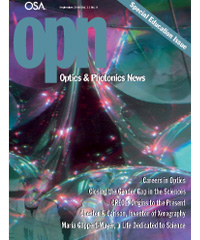
September 2000 Issue
Feature Articles
Chester F. Carlson: A Man To Remember
Chester Carlson’s invention of electrophotography, the process that gave birth to the modern-day photocopy industry, demonstrates how enormous can be the impact of a gifted individual working alone. Ultimately, it took teamwork to turn his invention into a series of successful products, but the path-breaking idea that put those teams to work came from one man, Chester Carlson. The personal and professional challenges he overcame along the way make the impact of his contribution even more remarkable.
by Dennis G. and Rita M. HallCREOL, From its Origins to the Present: My Experiences
The real origin for UCF’s optics activity came as a result of the energy and initiative of Bill Schwartz, the founder of Florida’s laser industry, and the effort by then-Governor Bob Graham (in the mid-1980s) to grow Florida’s economy beyond its dependence on tourism and citrus, two industries that traditionally pay low wages to many of their employees. The basic idea was to build value added, wealth-producing industries in Florida.
by M.J. SoileauClosing the Gender Gap in the Sciences
Following the achievements of the Civil Rights Era, in a world presumably characterized by a heightened awareness of the need for gender equality, many scientists are flummoxed about why women are still so vastly underrepresented in science.
by Peter HughesThe Scientific Life of Maria Goppert-Mayer
Researcher and educator Maria Göppert-Mayer, winner of the 1963 Nobel Prize in physics for her work on the nuclear shell model, loved science and learning. That love sustained her through the difficulties she encountered in pursuing her profession, including relocation from Europe to America prior to the war years and never being granted a full-time salaried academic position until she was 53 years old. A study of Maria Göppert-Mayer’s life reveals insights into the influence of her parents on her education and achievements, as well as into the role of her mentors, physicists James Franck and Edward Teller, on her professional development. Göppert-Mayer’s doctoral thesis, published in 1931, predicted multiphoton excitation processes and served as a precursor to the development of multiphoton excitation microscopy.
by Barry R. Masters

![A multiplexed image of a human tonsil acquired. [NIAID] using the iterative bleaching extends multiplexity (IBEX) method.](https://opnmedia.blob.core.windows.net/$web/opn/media/images/articles/2024/0424/departments/202404-cover-web.jpg?ext=.jpg)
